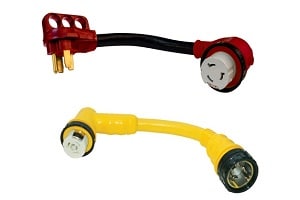Camping in an RV is one of the most enjoyable aspects of the entire experience. Traveling in an RV is more pleasant since you may bring along conveniences such as lighting, a stove, a mini-fridge, power outlets, and more. For the most part, you’ll need an RV power cord to supply all of that electricity to your appliances.

With an RV power cord, you’re connected to the electricity grid. They let you connect your RV’s electricity grid to a home, campsite, or RV park. All of your RV’s systems will be able to work at full capacity thanks to this source of electricity. When your RV isn’t connected to shore power, these power cords are also in charge of recharging the batteries so that you may keep using electricity when you’re not at home.
Power Cords for RVs Come in Several Forms
15-amp
If you’ve ever used a 15-amp power cord in your house, you’ll recognize it. These plugs feature three prongs, two thin vertical ones, and around ground wire beneath. Even though they’re well-known to the general public, RVs rarely utilize them. This is for one simple reason. A lot of RVers depend on electricity, and these systems just cannot provide that demand. Small camper and van-style setups are the most likely to employ them.
30-amp
In mid-size motorhomes with a single air conditioner, this type of 30-amp socket is popular.
On an RV’s power cord, a 30-amp plug has three prongs, too. With the thin prongs positioned at an angle instead of parallel / straight up and down, this plug is physically bigger than a 15-ampere one.
50-amp
RV power cables with a 50-amp rating are the most popular. The huge cords have four prongs: three horizontal flat ones and circular ground. Despite being referred to as a 50-amp connection, it provides two distinct 50-amp, 120-volt feeds.
Adaptors for RV Power Cords
You may choose from a variety of power cord adapters. You must get the type that is appropriate for your RV’s intended use.
If you have a 50-amp RV and the only service available is 30-amp, don’t worry! It’s possible to use an adapter for this purpose. About their design, they’ve been nicknamed “dog bones”.
Plugging in your RV’s 50-amp service into a 30-amp outlet requires a female to the male adaptor, like this one. There are no dangers to either RV or the power service if you utilize this method of connecting to the 30-amp shore power.
What to Consider Before Purchasing
Consider the following factors before purchasing a new power cord.
The Right Length
What if you can’t get power from a nearby wall outlet at home? Alternatively, do you frequently camp at RV parks with nearby electrical hookups? Keep in mind that cord length is a crucial consideration while purchasing.
If you’re unsure, it’s preferable to go a little longer than a little bit shorter. Investing a little more money upfront might save you a lot of hassle in the long run.
It’s Flexibility
Unfortunately, some RV electrical wires are rather rigid. Even while this may not seem like a major concern at first, grappling with these long, heavy-duty cables regularly may be a real pain. As long as all else is equal, you should go with the simplest option feasible.
Weather-Resistant Design
Because of this, it’s common for the power line of your RV to be left exposed to the weather. Depending on where you go, it might be exposed to the sun, wind, rain, or even snow! For long-term use, be sure that your new cord is weather-resistant. This will save you from having to go out and buy a new cord.
Now that you know how to use the power cord for your RV, you’ll be able to safely power up your mobile home while maintaining the highest levels of electrical safety and comfort. Visit RVUpgrades.com today for your power cord needs.
For more information about Travel Trailer Accessories and Water Softener For Rv Please visit: RVupgrades Store.



